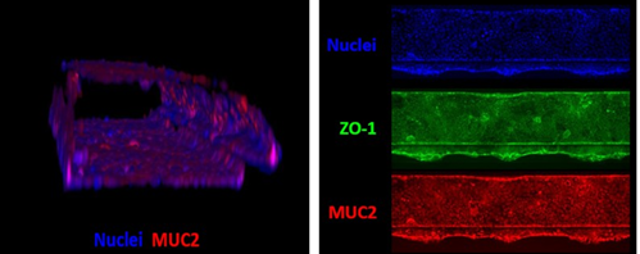 Leiden, November 23, 2021 – Scientists from MIMETAS and Astellas introduce a new method to study in vitro drug permeability based on 3D Caco-2 tubules cultured in the OrganoPlate® 3 lane-40. This article has just been published in the Journal of Pharmaceutical Sciences.
Leiden, November 23, 2021 – Scientists from MIMETAS and Astellas introduce a new method to study in vitro drug permeability based on 3D Caco-2 tubules cultured in the OrganoPlate® 3 lane-40. This article has just been published in the Journal of Pharmaceutical Sciences.
Drug absorption in the intestine is a critical step in orally-administered therapies. After oral dosing, the drug has to travel the gastrointestinal tract and be absorbed by the intestine into the bloodstream before it can be distributed to the site of action. By studying the mechanism of absorption, researchers can better predict the in vivo performance of novel drug compounds.
Current methods the pharmaceutical industry uses to study drug absorption by the intestine include the parallel artificial membrane permeability assay (PAMPA) and the Ussing Chamber model. The Ussing chamber model makes use of the complete structure of the human intestine. Even this model has high predictability, it suffers from technical and ethical issues as the intestinal tissues need to be sourced from human subjects. PAMPA on the other hand, only allows the researcher to determine passive diffusion of the drug compound across an artificial membrane. Considering the substantial drawbacks of the methods currently used, organ-on-a-chip technology can offer an impactful alternative for drug researchers to study intestinal absorption.
This publication set out to conduct a proof-of-concept study of a novel in vitro drug absorption method that employs a 3D-cultured intestine-on-a-chip model. By culturing Caco-2 cells in the OrganoPlate® 3-lane 40, distinct intestinal tubules were formed with both apical and basolateral access. The apical side of the intestinal tube was coated with a mucus layer to protect the Caco-2 cells from bile acid toxicity, which allows the researchers to determine the effect of bile acid on intestinal absorption without damaging the intestinal tissues. With the use of propranolol and solifenacin as exemplar compounds, the scientists show that the model can serve as an alternative testing system for measuring drug absorption in an environment closely resembling that of the human gastrointestinal tract.
